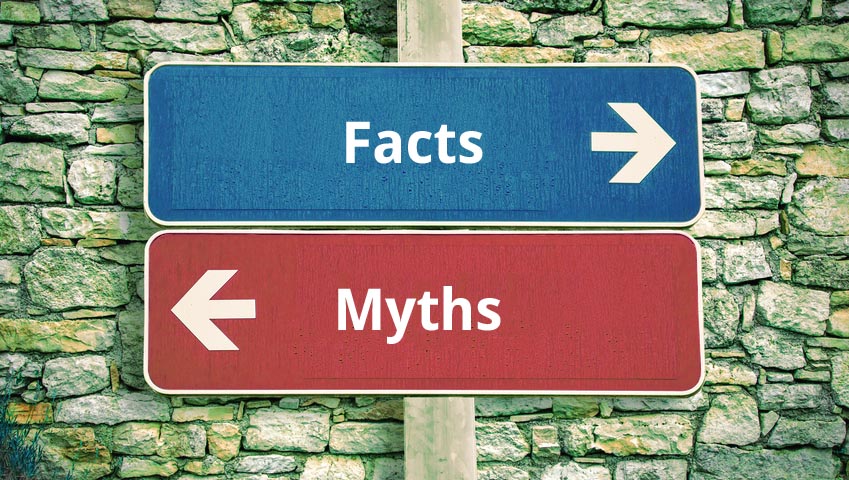There are many myths about domain names circulating on the internet. Some of these are in correlation with the new Top-Level-Domains, which were introduced in 2013. However, which of these are true and which are false? In the following article, SEDO will expose nine of the biggest domain name myths.
1. Social Network Profiles are more noteworthy than Domains
A common claim is that social network profiles are becoming more popular than their domain counterparts. However, experience shows that internet users like to use social media and websites simultaneously, without a preference for one over the other. An effective example of synchronizing these two mediums is by leaving a link to your website for visitors who view your Facebook profile page. Here, they will be able to receive information that cannot be displayed on your social media profile page. In doing this, the website retains its worth. In some cases, frequently visited social media profiles causes a proportionate increase in traffic to your website, increasing its value in the process.
2. New TLDs give you the best chances at effective marketing
The new Top-Level-Domains are comprised of around 2,000 new endings, which were introduced in 2013. Through these, the Top-Level-Domain ending spectrum has increased drastically. Endings like .bosch, .nyc, and .shop are now available and give the user a better understanding of what the potential product is going to be advertised on a website. This can be very practical, however, Google does not handle these new endings differently than endings like .com or .org. Due to this, the search results will still be in correlation to the characters in front of the TLD.
3. Good Domains are expensive
Some Domains are more popular than others are and can therefore be traded for higher amounts. However, one can never be sure which start-ups will make a big splash on the scene. Therefore, you should also invest in domains, which do not necessarily get their value from their affiliated companies or their corresponding products. Even though it can be a question of luck, as well as, knowledge of certain trends, inexpensive domains can translate into real gold mines.
4. New Top-Level-Domains only do decently in SEO-Rankings
Due to the amount of new Top-Level-Domains, it is understandable that certain endings no longer dominate the rankings as much as .com once did. However, sites like seo-hero.tech show that new Top-Level-Domains still place very highly in rankings. Experts from similar sites still see this trend and believe in it as well.
5. The new Top-Level-Domains are rarely used
Big companies are especially known under their .com domain. However, many companies are also branching out and extending their reach with new Top-Level-Domains. The new Top-Level-Domains are being used in 235 countries and are being managed by around 365 registrars. Overall there are 23 million new domains with over 1,200 extensions. With this amount of circulation, talk of how the usage of new TLDs is rare is obviously false.
6. .com is the true Top-Level-Domain for SEO
For a long time, it was only natural to be present with a .com domain online. After all, the "Commerce"-domain is a globally established identifier for the internet presence of companies. As a matter of fact, this remains true even today. With over 100 million registrations, the .com domain ending is by far the most used ending.
7. I can change my Top-Level-Domain anytime I’d like
It is actually possible to change your domain extension at any time. The prerequisite for this is that the new address with a changed top-level domain is still available for registration or already in your possession. However, the negative effects on the search engines have to be considered. Google needs a certain amount of time until the changed domain is registered. This could result in a transitional period during which your site's visibility in search results may be somewhat reduced. Furthermore, certain users expect email addresses to remain active for a certain period of time to finish their possible business within the account.
8. The .com-Domain is losing its significance
This rumor clearly contradicts our sixth rumor above. Nowadays even the .com domain is on the decline. But can that really be true? The .com domain is still the world's most used domain. Shares are being lost by the fact that the new top-level domains are on the rise. However, this is a natural process and does not threaten the .com domain.
9. A separate domain is needed for every one of my target audiences
It is absolutely possible to buy a domain with a matching extension for each country. But is this really necessary? If that was the case then in Germany, one would own their domain with a .de ending, in the Netherlands - .nl, but that is not a useful strategy. Instead, you can work with subfolders or subcategories under the main web address. For example, at IKEA, the visitor always visits the company’s website via the domain ikea.com. The country-specific content will then be in subfolders such as ikea.com/se/.
